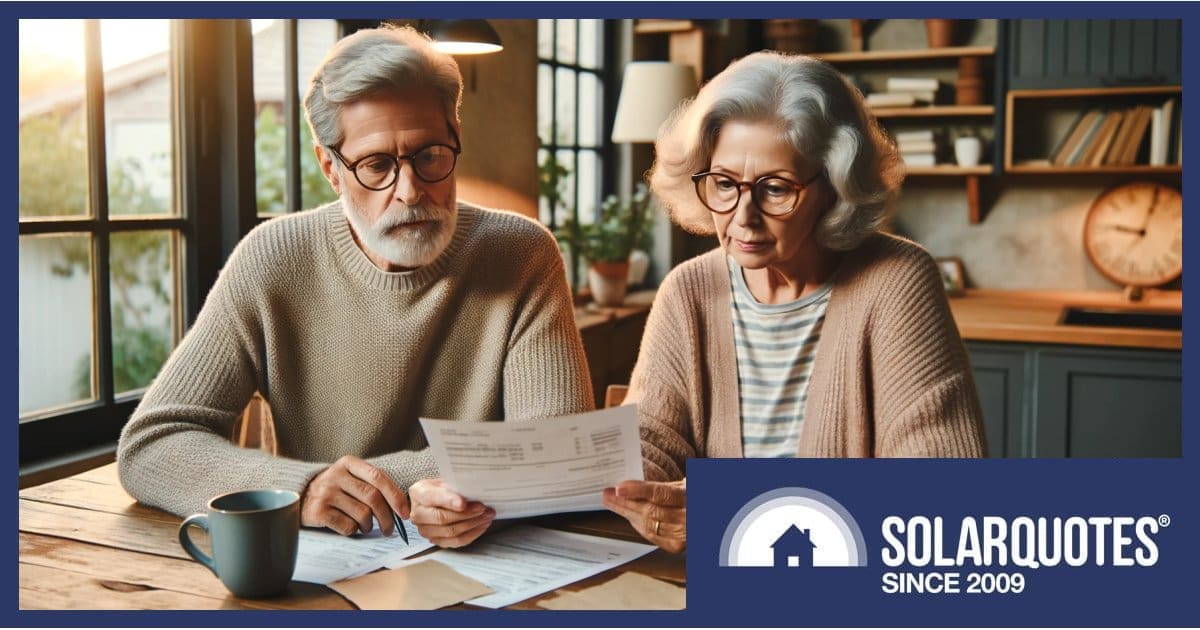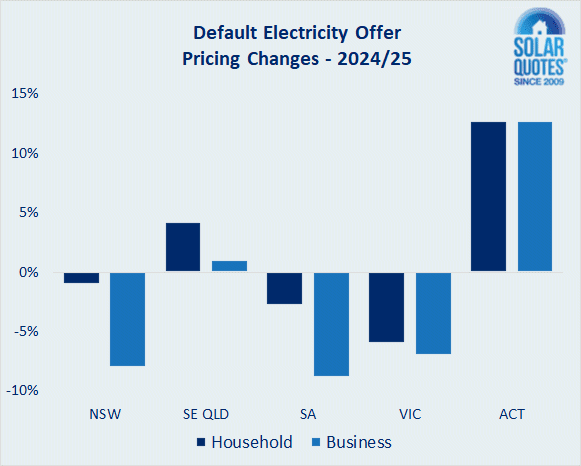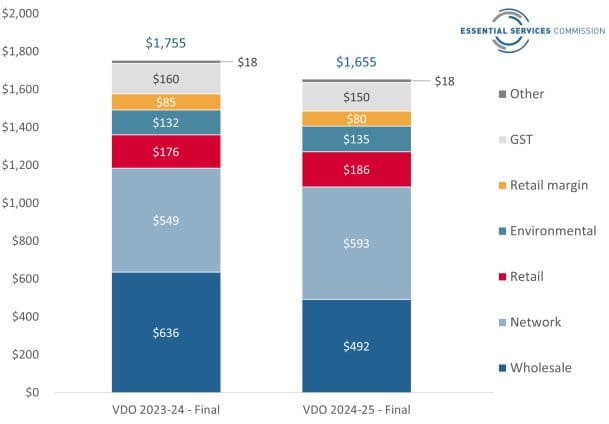
Final decisions were published yesterday for regulated electricity offers in several Australian states. Find out what this means and how it might affect you.
What Is A Default Offer?
A default offer is the maximum price an electricity retailer can charge a customer on a standing offer, which is a customer who hasn’t signed on for a market offer. It ensures these electricity customers aren’t gouged by as much as they otherwise may be.
While a minority of electricity customers are on regulated offers in most states, any changes tend to have a flow-on effect to market offers.
Who Sets Regulated Electricity Offers?
The Default Market Offer (DMO) covers retailers in Southeast Queensland1, South Australia and New South Wales, and is determined by the Australian Energy Regulator.
In Victoria, it’s called the Victorian Default Offer (VDO) and is set by the Essential Services Commission (ESC). In the ACT, the Independent Competition and Regulatory Commission (ICRC) sets standing offers.
In Tasmania, setting power prices is the job of the Tasmanian Economic Regulator. While covering a financial year, the Regulator tends to leave it until late June to announce changes.
In Western Australia, regulated electricity prices are determined by the State Government annually as part of the State Budget process, which was recently tabled. But after skimming over 800 pages of budget documents, I’m darned if I can find any information. Something the Cook Labor Government was happy to crow about was a $400 power bill credit for all households.
In the Northern Territory, The NT Government determines power tariffs and charges. Any changes usually cover a financial year and the NT government also tends to leave it until last minute to publish them.
Yesterday, the AER, ICRC and ESC published their final decisions for their respective jurisdictions, covering the 2024/25 financial year. While there’s generally been a significant reduction in wholesale electricity prices thanks in part to renewable energy; inflation and other costs – particularly those related to poles and wires (network costs) – have put a bit of a dampener on things.
VIC Households Winners
From 1 July 2024, the average rate Victorian Default Offer customers pay for their electricity will reduce by around 6% for residential customers and approximately 7% for small business customers..
“The impacts of lower electricity purchase costs were partly offset by increased network costs,” says the ESC.
The following breakdown is a bill comparison based on a domestic customer with annual usage of 4,000 kWh.
Ups And Downs In NSW, SE QLD And SA
The final DMO determination prices are very close to what was in the AER’s draft published in March.
In New South Wales, the DMO sees residential customers without controlled loads saving 0.9% to 1.1% nominal (without removing inflation), depending on distribution region. For small business, the reduction will be in the range of 0.7% to 8%. South Australians will be savers too, with a 2.8% reduction for households and 8.8% for small business without controlled loads.
But in Southeast Queensland, the DMO will increase by 4.2% for domestic and 1% for business customers without controlled loads. However, Queenslanders will be getting more financial relief than those in SA and NSW. In addition to the Federal Government’s recently announced $300 energy rebate that every Australian household will receive (including those with solar panels), all Queensland households will get a state-issued rebate of $1,000 to $1,372 and small businesses $325 – paid for from coal royalties.
Canberrans Hit In The Hip Pocket
ActewAGL’s Canberra customers on standing offers, both residential and small business, will see average price increases of 12.75% in 2024-25. Aside from inflation, the ICRC says this was mainly driven by increased network costs (determined by the AER) and the increase in the ACT Government’s large-scale feed in tariff (LFiT) scheme costs.
As for the other jurisdictions, any changes in the new financial year shouldn’t be far off being announced.
Market offers can be significantly lower than standing offers, so those on them could benefit by comparing electricity plans – as can households on market offers to ensure they are getting the best deal for their circumstances. A little legwork can make a significant difference to annual energy costs – but to really hammer your electricity bill, consider going solar.
Footnotes
- Outside of Southeast QLD the Queensland Competition Authority sets power prices, and it’s yet to publish its final determination for 2024/25. ↩



 RSS - Posts
RSS - Posts



If I’m reading this right network charges are going to rise about 10%. Does that mean a 10% rise in the daily connection fee and solar meter fee is likely?
This of course assumes average purchasing of 11 kWh per day. For households using less the proposed network charge increase will be proportionately more yes?
Is the drop in wholesale prices due to the drop in coal prices? It’s down from the high in 2022! : – D
The $400 for WA users happened as 2 X $200 credits to accounts
In QLD if I currently don’t pay a bill and I get $1300 in rebates the money is just going to sit on my electricity account each bill I get the FIT from my solar pays for any electricity consumption for the month from the grid Am I allowed to request the money refunded to my bank account as this would come in handy for the loan for my solar panels
Yes you can. If with Ergon you can do it online (just got $750 myself). Should be able to do same with Energex and other retailers too.
“…residential customers without controlled loads…”
What is a “controlled load” and how does the ordinary person know?
Good question, Denis.
It’s explained here:
https://www.solarquotes.com.au/good-solar-guide/electricity-connection-metering/
Scroll down to “Do you have a ‘controlled load’ supply?”